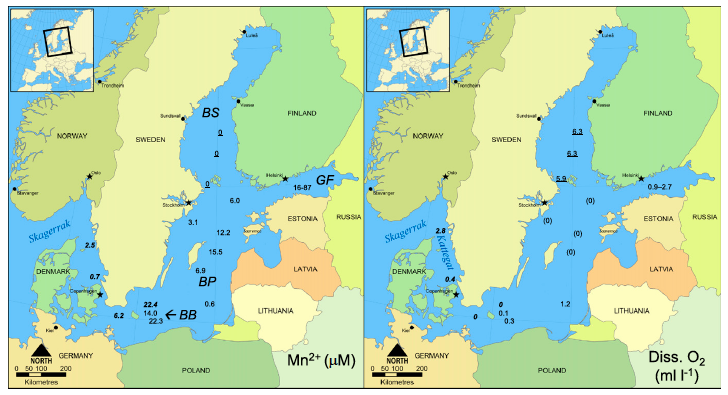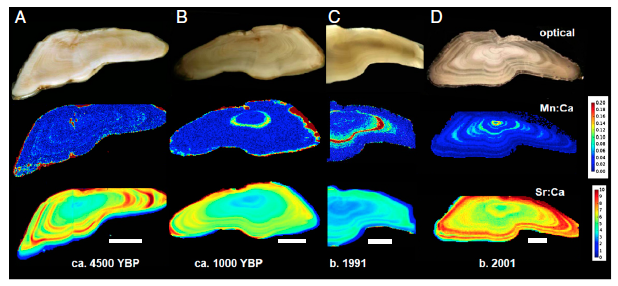X-RAY RUNS: Apply for Beamtime
2017 Nov 1 - Dec 21
2018 Feb 7 - Apr 3
2018 Proposal/BTR deadline: 12/1/17
2018 Apr 11 - Jun 4
2018 Proposal/BTR deadline: 2/1/18
Hypoxia refers to a pathological condition where an organism is deprived of an adequate supply of oxygen; anoxia refers to complete deprivation of oxygen. These terms are also used to describe regions of coastal environments with low concentrations of dissolved oxygen, which impacts fish habitat, in some cases so severely that these regions are colloquially known as "dead zones". Researchers are interested in studying how the migration habits of fish are effected by historical trends in hypoxia.
Otoliths, or ear-stones, are an integral part of the balance system in teleost fishes. These objects are made up of a protein and calcium carbonate matrix, and they grow by accretion, which produces ring-like features similar to tree rings. Trace metals can be incorporated into the matrix during accretion, and as a result, otoliths serve as a sort of time capsule, preserving information about environmental conditions. This information can be accessed at the synchrotron using scanning x-ray fluorescence spectroscopy to produce maps of the distribution of various trace elements in the sample. Strontium, for example, has been shown to vary with temperature and salinity, and has been used as a proxy to identify migration between fresh and salt water habitats. Variations in manganese content have also been observed, but experiments have not established a correlation of manganese content with temperature or salinity.
Manganese has several stable oxidation states, and is involved in redox chemistry. Karin Limburg and her team of researchers have collected many otolith samples from around the world's largest anthropogenic dead zone in the Baltic Sea, and hypothesized that variations in manganese content may correlate with hypoxia. Bottom waters in the Baltic containing low concentrations of dissolved oxygen were also found to contain relatively high concentrations of Mn2+ (see figure), possibly by allowing Mn2+ (or possibly Mn3+) to diffuse out of the sediments and into the water column.

Limburg et.al. looked at manganese content in otoliths dating from periods of low hypoxia in the early 1990s, and higher hypoxia in the mid 2000s, and found a positive correlation between high manganese content in the fishes first year of life and the extent of hypoxia. This provided an elemental signature that could serve as a useful proxy to establish historical trends in hypoxia from existing otolith archives. The group analyzed Neolithic-age otoliths as well, (dated 4500 and 1000 YBP), and found results consistent with low hypoxia (see figure). Their findings were reported in Proceedings of the National Academy of Sciences, volume 108, page E177-182 (http://www.pnas.org/content/108/22/E177). These results could provide the means to reconstruct hypoxia exposure histories and major patterns of fish migration near hypoxic regions from other otolith archives.

Submitted by: Darren Dale, CHESS, Cornell University
